How to Stop SoCal Air Quality from Affecting Your Home
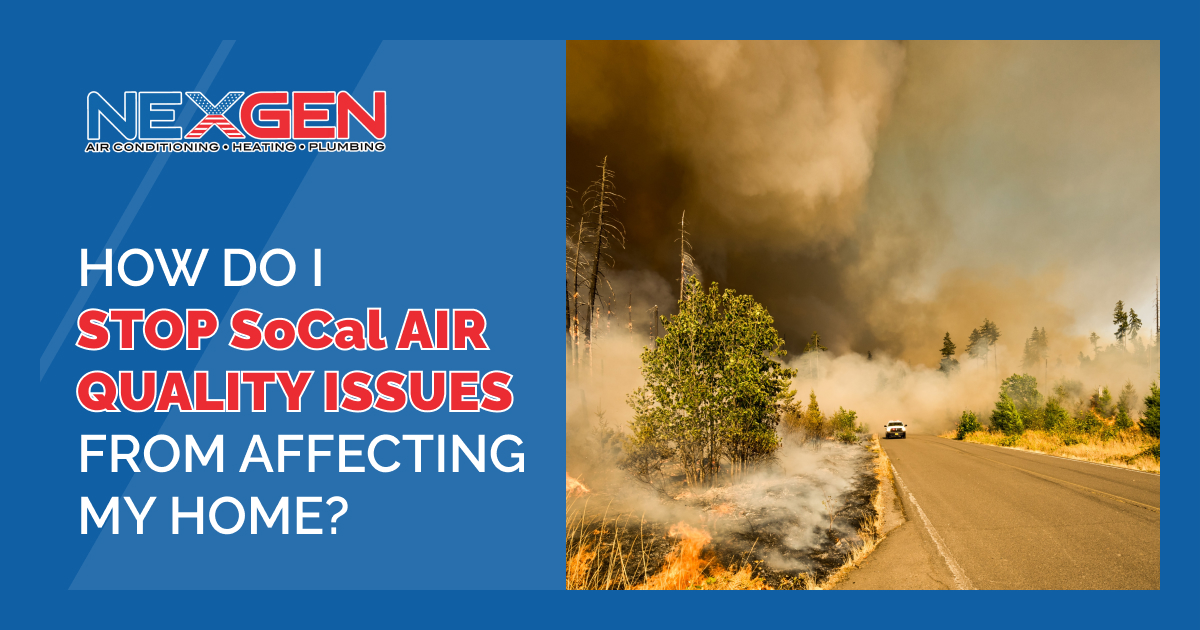 Southern California is renowned for its poor air quality. There are many sources of air pollution here, including motor vehicles, industry, seaports, dust, and smoke from wildfires that can drift hundreds of miles. Even if you’re not near a fire zone, busy road, or industrial area, your home can be affected by chemicals and small particles. But you don’t have to let SoCal air quality put your family at risk.
Southern California is renowned for its poor air quality. There are many sources of air pollution here, including motor vehicles, industry, seaports, dust, and smoke from wildfires that can drift hundreds of miles. Even if you’re not near a fire zone, busy road, or industrial area, your home can be affected by chemicals and small particles. But you don’t have to let SoCal air quality put your family at risk.
Why You Must Protect Yourself from Wildfire Smoke
Wildfire smoke appears dense and dark from a distance. It may seem you’re in the clear, but you can breathe it in and not realize it; many of the particles and chemicals aren’t visible to the naked eye. These can cause immediate symptoms such as coughing and difficulty breathing, irritated eyes, headaches, scratchy throat, dizziness, and chest pain.
Children, the elderly, and people with heart and lung conditions are most vulnerable. But smoke is bad for everyone. Exposure stresses the cardiovascular system, so severe exposure can lead to stroke and heart attack. Your home doesn’t have to be in the path of a wildfire for you and your family to be affected.
Protecting Your Home Against Poor SoCal Air Quality
You can reduce the risk of air quality issues polluting your home by:
Installing High-Efficiency Air Filters
Not all HVAC filters remove the particles found in SoCal air. It’s important to check, clean, and change filters often, but consider installing high-efficiency particulate air (HEPA) filters for increased protection. Particulate matter can be smaller than 2.5 microns in diameter and can reach the deepest parts of the lungs. By comparison, a single human hair is 50 to 70 microns in diameter. A HEPA filter will trap the tiniest particles as air circulates through your heating and cooling system.
Similarly, N95 respirator masks can protect against particulates, smoke, and COVID-19. Wear a mask if you must be outside in smoky or smoggy conditions. It should fit over the nose and under the chin; one strap goes above and one strap goes below the ears. Air should not pull in from the sides when you breathe in (if properly fit, the respirator will collapse as you do).
Keeping the Windows Closed
Closing all your windows is generally effective in keeping out air pollution. However, most homes aren’t perfectly sealed envelopes. So in addition to closing windows, use high-quality filters and fans that boost air circulation in your home.
Setting Your AC to “Recirculate”
If your air conditioning system recirculates and filters the air, instead of drawing it in from outside, you can reduce the chances of outdoor pollutants getting in. Close any vents that deliver outdoor air. Turn off the fresh air intake as well. Of course, this only works if the filter is clean, so be sure to replace your HVAC filter often and when it is dirty.
Using an Air Purifier
Purchase an air purifier that’s been tested for removing small particles. It should be non-ozone generating and approved by the California Air Resources Board (CARB). Mechanical air cleaners don’t generate ozone or ions and physically filter out the air using pleated or HEPA-style filters. While electronic filters may generate small concentrations of ozone, they can include technologies such as UV light, ionizers, or electrostatic precipitators.
How to Protect Yourself from Poor Air Quality
In addition to keeping dirty air out of your home, you can protect yourself from SoCal air quality issues with the following tips:
- Do not run a swamp cooler or whole house fan.
- Avoid vacuuming or dusting when air quality is poor.
- Use HEPA-filtered vacuums and wet mops.
- Refrain from using gas stoves or burning candles.
- Keep your central air “On” rather than using the “Auto” setting.
- Stay indoors and avoid overexerting yourself.
Contact NexGen for Indoor Air Quality Solutions
We offer a range of indoor air quality solutions for Southern California homes and businesses. These protect against particulates, volatile compounds, smoke, and more. When SoCal air quality turns for the worst, you can depend on NexGen to install the highest quality air filters, air cleaners, and air purification systems. We also provide high-quality duct cleaning, air duct sealing, and insulation services. Call 833-729-9735 to learn more.
6 Reasons to Get Indoor Air Quality Testing This Spring
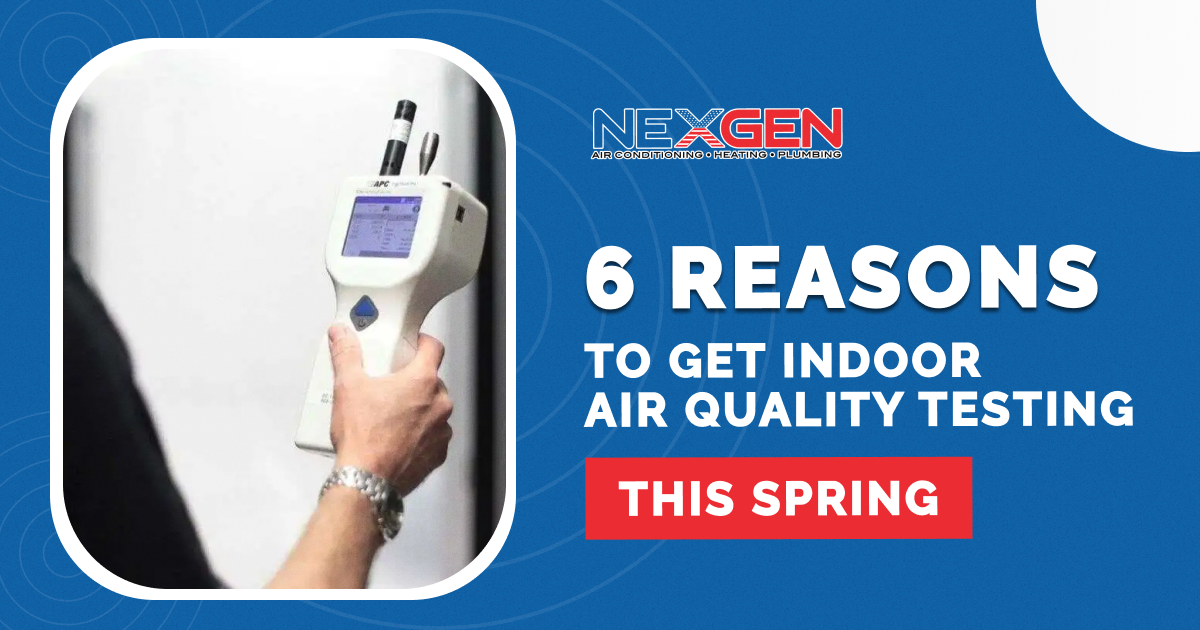
We often see springtime as a relief from the harshness of winter. It is also a time when activities, such as leaving the windows open or getting a deep cleaning done, can affect indoor air quality. Indoor air pollution can trigger allergies, worsen asthma, and cause headaches, nausea, coughing, sneezing, irritation, fatigue, and a host of other symptoms.
With indoor air quality testing, you can learn whether your symptoms are occurring for the following reasons:
1. Pollen Is in the Air
In most parts of the U.S., pollen counts soar in the spring. Trees, shrubs, grass, and flowers release pollen, which triggers a chain reaction in the body that causes allergies. Keeping your air conditioner filters clean or installing windowless ACs can help. Professional testing can determine if pollen, and what type, is affecting your home, so you can implement the best measures to reduce it. The best solutions are those that keep the pollen out of your home; regular vacuuming or installing air purifiers or high-efficiency particulate air (HEPA) filters can help.
2. Biological Pollutants
In addition to pollen, numerous biological pollutants can cause poor air quality in your home. Testing for mold, viruses, and toxins from microorganisms can help determine what steps to take. Mold spores are present indoors and outdoors and can stick to just about anything. When mold grows, it can cause respiratory issues even in healthy people. Testing is a good idea especially if you see visible mold; so you can take the appropriate actions.
Dust mites are another biological pollutant that can be reduced by keeping indoor humidity levels below 50%. You can also put impermeable covers over your mattress and pillows, and washing bedding in hot water. Removing dust with a damp rag and allergens with a vacuum can get rid of them as well.
3. Chemical Pollutants
Household products such as cleaners, disinfectants, paints, stored fuels, wood preservatives, furnishings can emit vapors and gases. Within these gases, volatile organic compounds (VOCs) can be often be found. These VOC’s are extremely toxic and cause a wide range of symptoms as well as organ damage.
Testing for VOCs should be done by an accredited lab to ensure accurate results. You can often reduce VOCs by increasing ventilation, discarding old chemicals, and using products as directed by the manufacturer. Some particularly concerning compounds include benzene, a known carcinogen found in paints, fuel products, and tobacco smoke, as well as perchloroethylene and formaldehyde.
4. Combustion Pollutants
Many people don’t realize the abundance of combustion pollutants in their homes. Environmental tobacco smoke, or secondhand smoke, contains thousands of potentially harmful compounds. It has resulted in thousands of deaths among non-smoking adults and respiratory conditions in children. Parents who smoke unknowingly put their kids at risk.
Carbon monoxide (CO) is also a combustion pollutant. The colorless, odorless gas prevents the blood from absorbing oxygen and, in high concentrations, can be deadly. It can originate from unvented space heaters, fireplaces, woodstoves, and gas stoves as well as damaged or poorly maintained furnaces. While air quality testing can help detect CO, the U.S. Consumer Product Safety Commission (CPSC) recommends use of UL-approved carbon monoxide alarms and regular inspection of fuel-burning appliances.
5. Radon
A radioactive gas, radon occurs naturally in soil and can move up from the ground, through cracks and holes in a foundation, and into your home. Breathing in radioactive particles can cause lung tissue damage and, in some people, lung cancer. The U.S. Environmental Protection Agency recommends testing for radon in any home below the third floor, starting with a short-term test and another after a high result. A long-term test can provide a clearer perspective of radon levels present year-round. If radon is high in your home, you can install a vent pipe and fan to address the problem.
6. Indoor Air Pollution Can Make You Sick
In addition to allergies, asthma, and irritated eyes and throats, there are even more greater health concerns associated with indoor air pollution. High levels of lead can cause convulsions, coma, and death, but long-term exposure to low levels can cause central nervous system and brain damage; it can harm the kidneys and blood cells as well. In children, it can lead to a shorter attention span, behavioral problems, and a lower IQ.
The effects of mold, tobacco smoke, carbon monoxide, and VOCs are well-known. For the health of your family, it is important to consider indoor air quality testing if you haven’t done so already. The everyday cleaning products you use may be putting your health at risk as well. These are just a few important considerations to think about this spring.
Trust Nexgen for Air Quality Testing and Improvements
The leading HVAC company in Southern California, we can help with indoor air quality testing and provide effective improvements to deal with common pollutants. Our HVAC technicians are familiar with the latest solutions. We guarantee quality and competitive pricing as well. To learn more about our indoor air quality services and schedule an appointment, call 833-729-9735 today.
Why is your HVAC system important when living in Los Angeles?
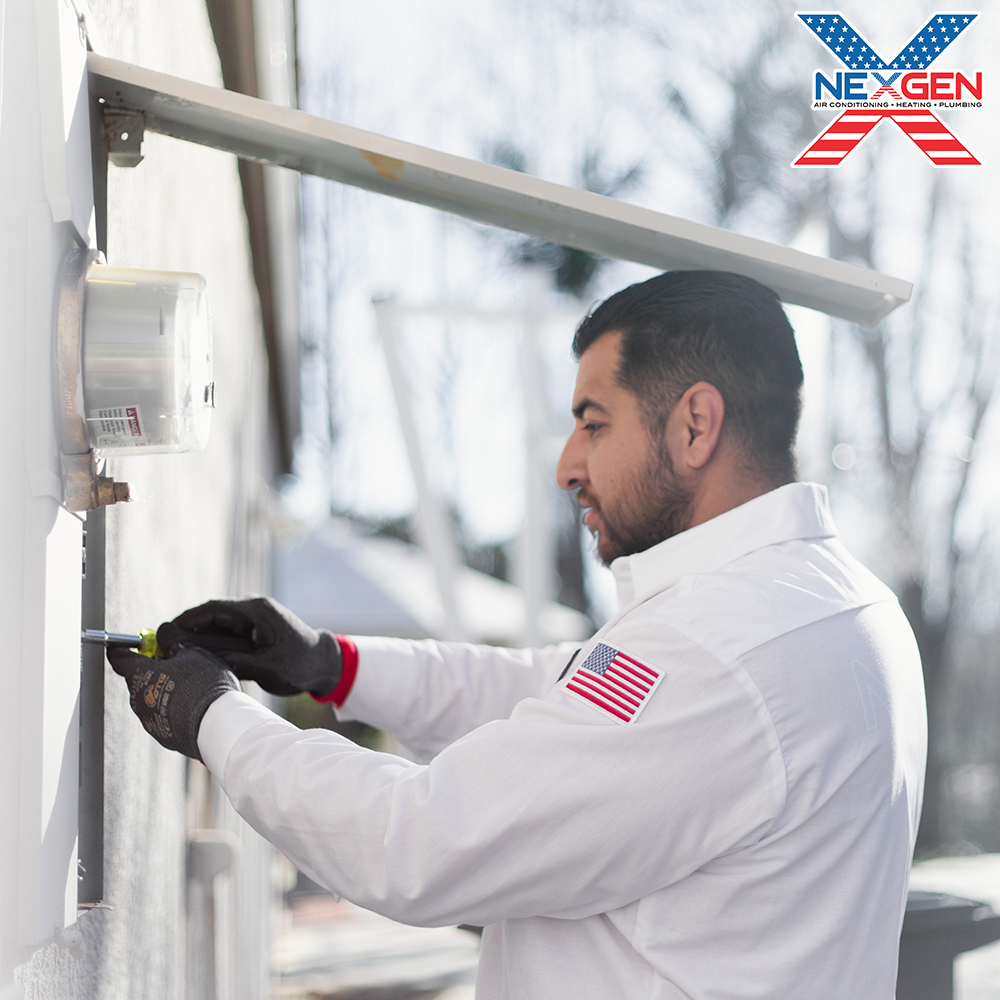
Heating, ventilation, and cooling, abbreviated as HVAC, is a system that cleans the air and offers warm air or cold air depending on the user’s climate requirements. In Los Angeles, HVAC systems are considered a worthy investment because of their incredible energy-saving principles.
If your HVAC system is damaged or is more than 15 years old, you must upgrade to a brand new, high-efficiency HVAC equipment. At NexGen, we offer professional repair and installation solutions on all AC systems in Los Angeles. We can assist you with all the heating and air conditioning systems requirements you need.
Pros of Having an HVAC System in Los Angeles
Because of advancements in technology, present-day HVAC systems can maintain a constant temperature in all the rooms in your home. Quality HVAC equipment has top-notch energy control and offers a consistent level of airflow. Pair this HVAC system with a smart thermostat and a comfort zone control system, and your home becomes an energy-efficient fortress. All of these also ensure you have a more comfortable and updated house to live in.
Lower Electricity Bills
An HVAC system is a piece of energy-efficient equipment that can significantly lower your electric bill to a great extent. Moreover, switching to a more advanced HVAC system reduces your carbon footprint, which is a significant step to preserve our unique planet from pollution.
Cleaner Air
Having a smart HVAC equipment enables you to have a constant flow of clean air. This helps to reduce stuffiness and drafts. Here at NexGen, we will install an HVAC system that ensures stable comfort levels and boosts the quantity of fresh air.
The Best Air Conditioning Service in Los Angeles
If you are hunting for dependable AC repair in Los Angeles to handle all of your heating needs, then NexGen is here to help. Our team can keep your HVAC system maintained and ensure your home is having a constant flow of cold air. We provide full heating and air conditioning services on residential properties within Los Angeles and the neighboring areas.
State-of-the-art Tools and Equipment
At NexGen, we have invested in great repair tools. We use state-of-the-art technology to make sure you get the best HVAC service. Our incredible team of technicians have extensive experience and use their remarkable skills to give you top-of-the-line AC repair solutions.
Exceptional Customer Care
We give our clients the number one priority always, and as our customer, we will handle your HVAC system repair with the professionalism that the project deserves. Our family will treat you like family. Our team commits to going the extra mile.
Request for a Free Estimate
Looking for the best air conditioning repair in Los Angeles? Call us at NexGen today for high-quality AC repair, excellent customer support, and affordable costs. You can contact us for a free consultation and estimate on all the AC services we provide.
Call NexGen Today
Our expertise and commitment to customer satisfaction make us the leading HVAC company in Southern California. To learn more about our equipment, services, and protection plan,
book an appointment online or call
888-277-0415.
Nicotine Residue from Smoking Can Transfer Between Rooms Through Your Vents
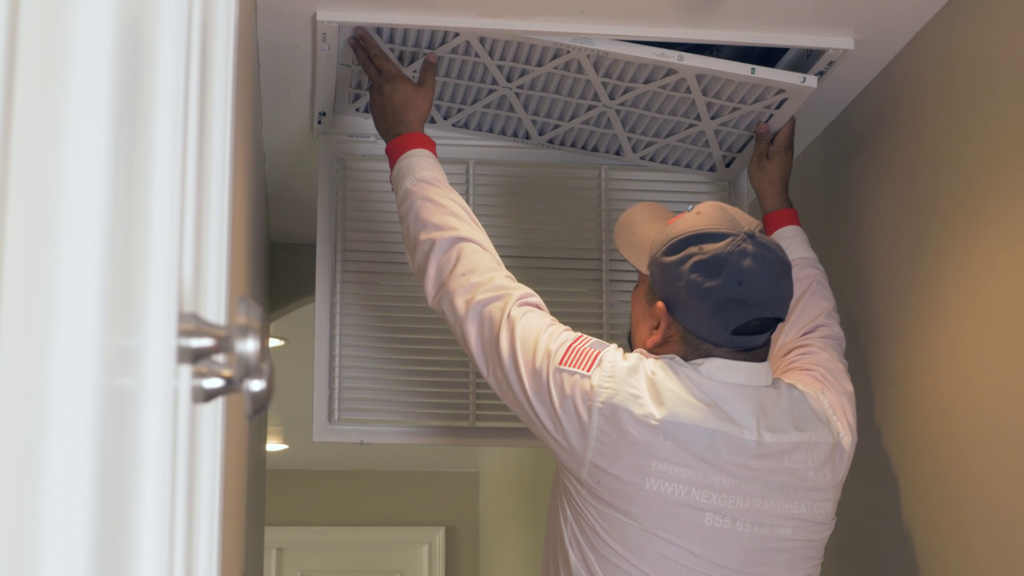
It’s been years since people regularly smoked cigarettes indoors in public places and office environments. Most people don’t even smoke cigarettes indoors at home.
But:
With the recent advent of vaping e-cigarettes, there has been a revival of the indoor smoker. Because of this resurgence in indoor smoking, we’d like to discuss how smoke from vaping can affect your HVAC system, your home, and your air quality.
Although it’s believed that e-cigarettes are a cleaner smoke than cigarettes, there are still some residues left over including nicotine and carcinogens from burnt organic materials.
So how do these residues affect your home?
Nicotine and other substances that make up smoke can move through your home’s air vents and leave residues on surfaces in other rooms of your house.
There has not been much study done to the chemical composition of exhaled e-cigarette smoke, so there may be many more chemicals involved that can lower the quality of your air.
What makes e-cigarette smoke even more unpredictable is the fact that the manufacturers of e-cigarette refill fluids have various flavors and are always changing their ingredients, making for a wild-card situation when it comes to knowing what is actually being circulated throughout your home’s air vents.
What can you do about residues from e-cigarette smoke?
We’re not here to tell you whether you should smoke e-cigarettes or not, but if you or someone in your home does, there are a few steps to take to ensure your air quality stays optimal.
- First off, just smoke outside. Vaping doesn’t have the same social stigmas that cigarettes have when it comes to smoking indoors, but if you’re worried about the air quality of your home, the easiest way to prevent your air from being tainted with smoke residue is to just smoke outside.
- With a small investment, you can get an air purifier. This should help purify the air in the room you’re in, but smoke may still travel through your vents into other rooms. If you’d like to purify your entire home, you can either close the vents in the room you’re in or invest in an air purifier in every room. We do have to mention however that closing your vents may not ensure that smoke won’t leak into other rooms.
We hope you have the information needed to make an informed decision about your home’s air quality in relation to e-cigarette smoke. If you’d like to know more about air purification or would like to schedule an appointment for a NexGen technician to come over and consult you about your air quality, call us today!
Call NexGen HVAC & Plumbing
Our expertise and commitment to customer satisfaction make us the leading HVAC company in Southern California. To learn more about our equipment, services, and protection plan, book an appointment online or call 888-277-0415.
Southern California has the worst air pollution in the USA

If you've ever seen a brown haze of pollution hanging over your city, your most likely response may be, "Ugh. How can I avoid breathing that stuff?" But let's face it, even if you know it's a bad air day, you probably need to grab some sunshine, get in an outdoor run, or get to work.
Polluted air contains particulate matter, lead, ozone, nitrogen dioxide, carbon monoxide, and sulfur dioxide -- all of which can cause problems in people with allergies or asthma. Even if pollution is low, airborne pollen and mold can make a trip outdoors particularly daunting for people with respiratory conditions.
How to tell if it's a bad air day
The first step toward protecting your lungs is to know your city or town. More than 115 million people nationwide still live in counties with pollution levels considered potentially harmful to their health.
Air quality varies widely around the United States. Ozone, for instance -- which can pose a major problem for asthmatics -- tends to be more prevalent in urban areas like Los Angeles, though it can be found in suburban and rural areas as well. If you live in Fargo, North Dakota -- one of the cities with the cleanest air in the nation -- you are likely to breathe easier than if you live in Los Angeles, which has the highest ozone levels in the country.
Local weather stations often provide this information on their websites, and radio stations typically give ozone alerts. In addition, many websites can tell you if pollutants, ozone, or pollen counts are high in your area on any given day.
- AirNow.gov, a site run by federal government agencies, provides a daily Air Quality Index as well as other useful information on air quality.
- The American Academy of Allergy, Asthma & Immunology National Allergy Bureau has a daily mold and pollen report.
- The American Lung Association rates the air quality annually by state at stateoftheair.org.
- The Environmental Protection Agency has a feature on its website called My Environment, which gives you an up-to-date air-quality forecast for your zip code.
- Pollen.com offers a four-day allergy forecast using data from the National Weather Service.
However, it's not just pollen or air pollution that can trigger problems. Dr. Michael Benninger, M.D., the chairman of the Head and Neck Institute at the Cleveland Clinic, in Ohio, says changes in barometric pressure and temperature can also spell trouble for people with allergies to pollen and mold, people with severe sinus symptoms, and even people without allergies.
How to cope with bad air days
Once you've figured out what factors are most likely to pose a problem (usually by trial and error, or testing for allergies), and know the conditions in your area, there are several things you can do to cope.
One option is to reduce excessive exposure on days that might trigger symptoms. For example, Benninger recommends avoiding areas where pollen, mold, or other allergens are high. If you know that grass and trees are a problem, don't spend the day in a lush, tree-filled park; if you have to mow your lawn, wear a mask with a filter to reduce exposure to grass. Staying indoors with the windows closed and the air-conditioning on is also helpful, Benninger says.
Call NexGen Today
Our expertise and commitment to customer satisfaction make us the leading HVAC company in Southern California. To learn more about our equipment, services, and protection plan,
book an appointment online or call
888-277-0415.
Can HEPA filters Stop Allergies?
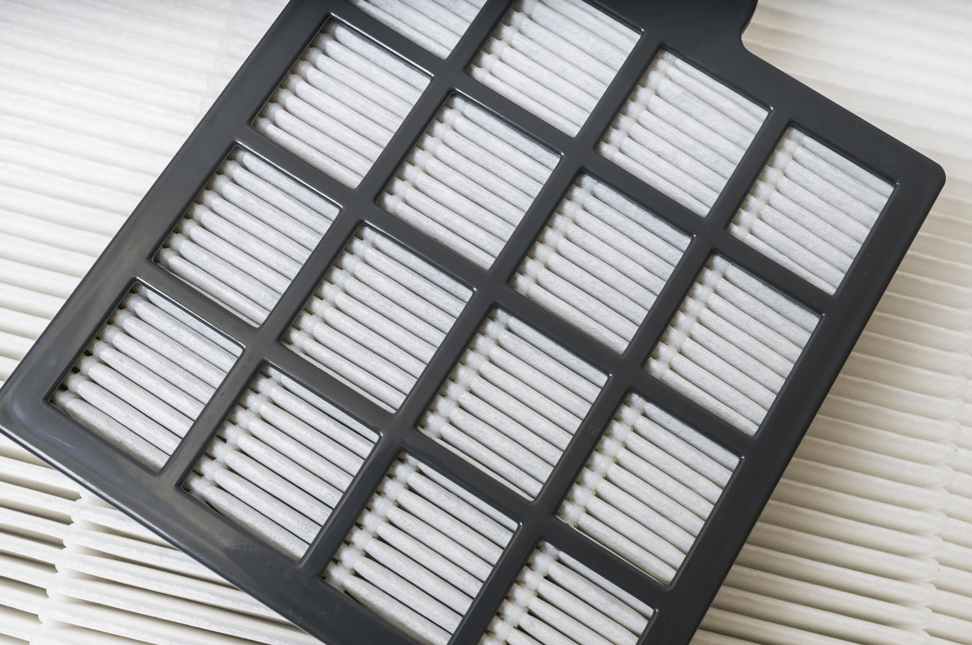
Flowers are blooming, the grass is green and lush, and trees are bursting with new leaves… Don’t you just love this time of year?
Not so much if you have allergies.
When the pollen count is out of control, all you want to do is hide in an air-conditioned room until fall. Unfortunately, that probably won’t help.
You might think your air conditioning system will filter out all those nasty allergens from the air, but without the right air filters for allergies, you’ll still be sniffling and sneezing your way through the season.
And it’s not just pollen you need to worry about! The summer heat and humidity make the conditions ripe for the growth of mold and mildew, which can also bring on allergy symptoms.
Learn the facts about choosing the right air filters for allergies, as well as other HVAC maintenance tips that can reduce your suffering this season.
Fact #1 About Air Filters for Allergies:
Regular HVAC filters are intended to protect the equipment, not your lungs and sinuses.
Many people mistakenly believe that the air filters in furnaces and air conditioners keep dust and allergens out of the air.
That’s not what HVAC filters are designed to do. Their purpose is to keep dust out of the equipment to prevent damage to the system and keep it running efficiently.
While ordinary furnace and ac filters do help to remove some dust from the air (when changed regularly!), they do little to trap the microscopic particles that cause the sneezing and wheezing of allergy season.
That’s why you need special air filters for allergies that are designed to stop those tiny particles.
Fact #2 About Air Filters for Allergies:
Ordinary paper filters can’t trap allergens.
Those paper filters ordinarily used in your furnace and air conditioner are designed to trap large particles like dust that can accumulate on the motor and fans and reduce efficiency. However, particles like mold, bacteria, and certain types of pollen are much smaller in size, so they slip right through the fibers of those regular filters.
That means they get circulated through your ductwork and blown back into your space.
Air filters for allergies are designed to block much smaller particles, so your air stays cleaner. They are called “high energy particulate air filters” or more commonly, HEPA filters.
Because HEPA filters are made from densely packed layers of glass fibers instead of paper, the best ones can trap more than 99 percent of pollen, dust and smoke particles and keep them out of the air you breathe every day.
Fact #3 About Air Filters for Allergies:
All HEPA filters are not created equal.
Unfortunately, it’s not good enough just to look for a HEPA filter for your air conditioner. To get the best results, you need to check the MERV ratings.
HVAC HEPA air filters for allergies are rated on how well they block particles of different sizes. The rating system is called the minimum efficiency reporting system, or MERV. The ratings range from MERV 1 to MERV 12, with the higher number indicating filters that can remove the smallest particles, including many species of pollen.
Your HVAC service professional can help you get and install the best MERV-rated filter for your air conditioning and heating systems. Ideally you want to choose a MERV rating of 10 or higher, which are most effective at blocking the particles that cause allergy symptoms.
Fact #4 About Air Filters for Allergies:
You need to change those filters more frequently than you think.
HEPA air filters for allergies need to be changed more frequently than ordinary paper HVAC filters, especially during high pollen season.
That means changing them at least every other month, and possibly more often depending on your location. An HVAC service expert can advise you on what’s recommended for your equipment and your area.
Fact #5 About Air Filters for Allergies:
The right filter is only half the story.
Using the right air filters for allergies does help to reduce the allergens in the air, but don’t forget about cleaning it from the rest of your HVAC system. If you haven’t had your air conditioning system maintained at least once every year, you’ve likely got quite a bit of buildup on the blower fans and in your ductwork.
Did you know that the air you breathe cycles through your HVAC system about 5 to 7 times each day? If you have not been using the right HEPA air filters for allergies AND not maintaining your air conditioning system, years’ worth of dust, pollen and even mold spores are sitting in on your equipment and in your ducts right now.
Check out our list of 31 HVAC tips to learn about even more air quality and AC tips for your home!
Call NexGen HVAC & Plumbing
Our expertise and commitment to customer satisfaction make us the leading HVAC company in Southern California. To learn more about our equipment, services, and protection plan, book an appointment online or call 888-277-0415.
Indoor Air Quality Testing Los Angeles
 How To Ventilate Your Home
How To Ventilate Your Home
Most home heating and cooling systems, including forced air heating systems, do not mechanically bring fresh air into the house. Opening windows and doors, operating window or attic fans, when the weather permits, or running a window air conditioner with the vent control open increases the outdoor ventilation rate. Local bathroom or kitchen fans that exhaust outdoors remove contaminants directly from the room where the fan is located and increase the outdoor air ventilation rate.
When To Ventilate Your Home
It is particularly important to take as many of these steps as possible while you are involved in short-term activities that can generate elevated levels of pollutants — for example, painting, paint stripping, heating with kerosene heaters, cooking, or engaging in maintenance and hobby activities such as welding, soldering, or sanding. You might also choose to do some of these activities outdoors if you can and if the weather permits.
More Home Ventilating Options
Advanced designs of new homes are starting to feature mechanical systems that bring outdoor air into the home. Some of these designs include energy-efficient heat recovery ventilators (also known as air-to-air heat exchangers).
Ventilation and shading can help control indoor temperatures. Ventilation also helps remove or dilute indoor airborne pollutants coming from indoor sources. This reduces the level of contaminants and improves indoor air quality (IAQ). Carefully evaluate using ventilation to reduce indoor air pollutants where there may be outdoor sources of pollutants, such as smoke or refuse, nearby.
The introduction of outdoor air is one crucial factor in promoting good air quality. Air may enter a home in several different ways, including
- through natural ventilation, such as through windows and doors
- through mechanical means, such as through outdoor air intakes associated with the heating, ventilation and air conditioning (HVAC) system
- through infiltration, a process by which outdoor air flows into the house through openings, joints and cracks in walls, floors and ceilings, and around windows and doors.
Infiltration occurs in all homes to some extent.
Natural ventilation describes air movement through open windows and doors. If used properly natural ventilation can at times help moderate the indoor air temperature, which may become too hot in homes without air-conditioning systems or when power outages or brownouts limit or make the use of air conditioning impossible.
Natural ventilation can also improve indoor air quality by reducing pollutants that are indoors. Examples of natural ventilation are:
- opening windows and doors
- window shading such as closing the blinds
Most residential forced air-heating systems and air-conditioning systems do not bring outdoor air into the house mechanically, and infiltration and natural ventilation are relied upon to bring outdoor air into the home. Advanced designs for new homes are starting to add a mechanical feature that brings outdoor air into the home through the HVAC system. Some of these designs include energy efficient heat recovery ventilators to mitigate the cost of cooling and heating this air during the summer and winter.
When adding outside air in order to dilute the pollution within your home is not an option, there are a few other options. HEPA air purifiers which are separate from your homes HVAC system can be effective. If this is not an option many newer homes have an air filter cabinet located on top of or underneath the furnace depending on whether it is an upflow or downflow model, putting a charcoal or other type of particulate filter in can help reduce pollutants within the home.
Call NexGen Today
Our expertise and commitment to customer satisfaction make us the leading HVAC company in Southern California. To learn more about our equipment, services, and protection plan,
book an appointment online or call
888-277-0415.
10 Ways to Improve Your Indoor Air Quality
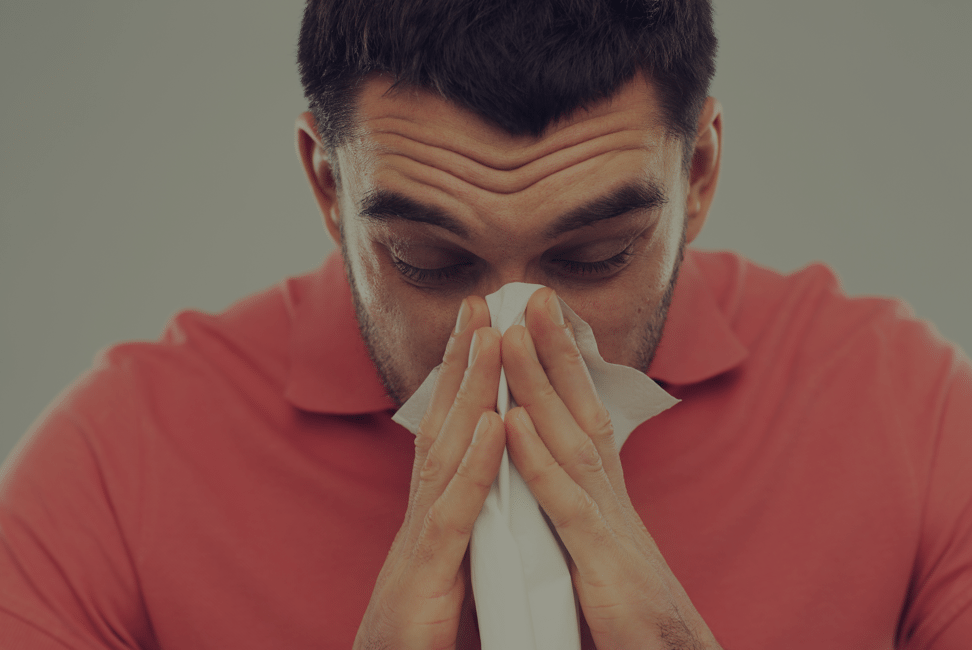
Did you know that some air pollutants are 2-5 times more common indoors than outdoors? This means that when you sleep or spend time at home, you could be breathing in harmful pollutants. Thankfully, there are all sorts of ways to make sure your air quality is healthy. Try some of these tips today to start breathing better.
1. Avoid smoking indoors.
One of the most common and most harmful substances for your air is cigarette smoke, which releases hazardous air pollutants like formaldehyde and ammonia into the air. If you can stop smoking altogether, with the help of medication or a support group, that’s your best bet. Otherwise, try to smoke only outdoors, at least ten feet from your windows.
2. Keep floors and surfaces clean.
Dust mites, mold, pet dander, and other natural air pollutants can cause respiratory problems and aggravate allergies. Be sure to clean your home regularly--even the hard-to-reach corners, where dust and hair build!
3. Clean your air filters.
Your HVAC filters, especially for your heater or furnace, can’t do their job unless they’re replaced properly. Follow the manufacturer’s instructions, which usually recommend replacement every 90 days, or more frequently with pets or allergies.
4. Use a HEPA filter.
Not sure if you have decent air filters? Install a HEPA filter, which is an air quality system that removes at least 99.7% of particles in the air. For people with allergies or poor ventilation, a HEPA filter is a lifesaver.
5. Get some plants.
Get some plants. Indoor plants can work wonders for indoor air quality. They’re natural air filters, and also produce the oxygen we breathe. Plus, they look great in any home!
6. Test your indoor pollutant levels.
Many homes have high levels of radon, formaldehyde, or other pollutants--even if they’ve done everything right. These chemicals can enter a cracked foundation of a home through soil or into the air through the building materials. Contact us today to quickly and easily test your home’s pollutant levels.
7. Avoid using products with high VOC levels.
VOCs are “volatile organic compounds,” which can cause respiratory problems and other health issues. Though they also occur naturally, in high concentrations they can be extremely harmful. VOCs are found in many aerosols, pesticides, paints, and more. Limit your VOC usage whenever possible to keep your air cleaner.
8. Use a humidifier.
The ideal humidity of a home is 30-50% humidity. This is humid enough to keep your body and houseplants happy, but dry enough to avoid mold. If you don’t live in a place with good humidity, it may be worth it to get a humidifier to keep your air quality strong.
9. Vacuum regularly.
Try to keep dust, particles, pet dander, and more in a vacuum instead of in your lungs. Also be sure to dump the waste regularly, and keep the vacuum filter clean. Along with automatic air filters through your HVAC system, this can be a huge help.
10. Open the windows!
Open the windows! Finally, a little fresh air can do a world of good! If weather permits, open a few windows in your home to improve ventilation and circulation. And if it gets too warm, we also provide great air conditioners.
Contact us over at NexGen today to install air filters, get your pollutants tested, or for other air quality services. We would love to help you and your family start breathing a little easier.
Call NexGen Today
Our expertise and commitment to customer satisfaction make us the leading HVAC company in Southern California. To learn more about our equipment, services, and protection plan,
book an appointment online or call
888-277-0415.















